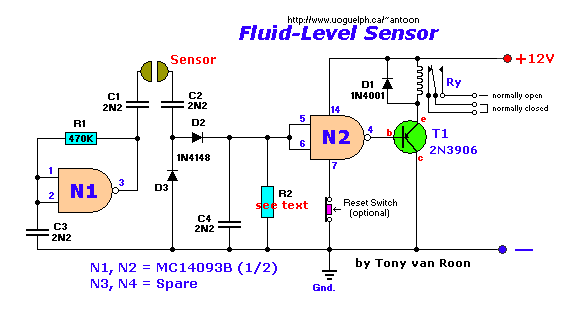
Parts List:
R1 = 470K N1,N2 = MC14093B
R2 = 15M* T1 = 2N3906 (these will work also: PN200, 2N4413)
C1-C4 = 2N2 (2.2nF) (NTE159, ECG159, BC557, BC157, TUP)
D1 = 1N4001 Ry = Relay (12V or matching supply voltage)
D2,3 = 1N4148 Sensor = Stainless Steel probes, brass, chrome, etc.
The above circuit uses an AC-sensing signal to eliminate electrolytic corrosion on the probes. The AC signal is
rectified and used to drive Transistor T1 that drives the relay. The relay is a 12-V type of your choice.
Transistor T1 can also be a TUP. Check out the TUP/TUN document for a large selection
of European transistors and what this system is all about.
Diodes D2 and D3 are both small signal diodes (1N4148). Diode D1 (1N4001) eliminates transients and possible
sparking over the relay coil. Do not use a signal diode for this but a rectifier diode like the 1N4001 or other
types of the 1N400x series.
Resistor R2 controls the sensitivity. Also your choice. Select one between 10 and 22 Mega-ohm, or use a trim-pot.
The MC14093B is a CMOS quad 2-input NAND Schmitt trigger. The
supply voltage can be between 3.0 and 18Vdc. It is pin-for-pin compatible with the CD4093. The capacitors are
standard ceramic types but try others if you have them available.
Please note: Unused inputs MUST be tied to an appropriate voltage
level, either ground or +12V. In this case, tie input pins 8, 9, 12, and 13 to either ground or +12v. Unused
outputs (10 & 11) MUST be left open. You can use them as
spares when needed.
In regards to the sensor, use your imagination. Stainless steel would be preferred but try other materials too.
Depending on what type of fluid you use it for you naturally would choose your type of sensor which would resist
corrosion for that particular fluid. I often use chrome bicycle spokes with very good success. The 'Sensor' works
via the capacitive method.
The "RESET" switch in the circuit is optional. The relay can be replaced with anything you like; buzzer, lamps, other
relays, etc.
Thanks, Tony, for publishing your Fluid-Level Sensor design. I'm using it to detect sewer line plugs (water backing
up toward the access port), and hot water heater / clothes washer / AC condensate pump overflows/leaks (water on the
basement floor). It works very well.
Also, it says "the 'Sensor' works via the capacitive method."
But I don't think that is correct. It would be more accurate to say that, for detecting fluids that are perfect
insulators, the circuit CAN be made to work by detecting an increase in capacitance when the fluid replaces air in
an air gap in the sensor.
But for the more common case of fluids that are not perfect insulators (like water on my basement floor), the circuit
works by detecting resistive conduction through the fluid. It is lowered resistance that is detected, not increased
capacitance.
To detect insulating fluids via the capacitive method would require good sized plates separated by an air gap, and
careful adjustment of the sensitivity via R2 to distinguish between the possibly small change in capacitance due to
the presence of the fluid. The difference might be small because there is only a fairly small differences between
the dielectric constants of air and some common fluids. E.g., air has a dielectric constant of 1, and typical oils
have dielectric constants of 2 to 5. Note, too, that desire to get a measurably large amount of capacitance leads us
to desire that the gap between the plates be small (because the capacitance is inversely proportional to the distance
between the plates), but the gap cannot be too small, lest capillary action hold fluid between the plates even after
the fluid level has dropped below our sensor.
But to detect dirty water or tap water you can use almost anything: even a pair of bare wire ends several am apart
works just fine.
Also, one handy feature not mentioned in the article is that several resistive "sensors" can be hooked up together (in
parallel) to detect fluid at any of several different locations.


